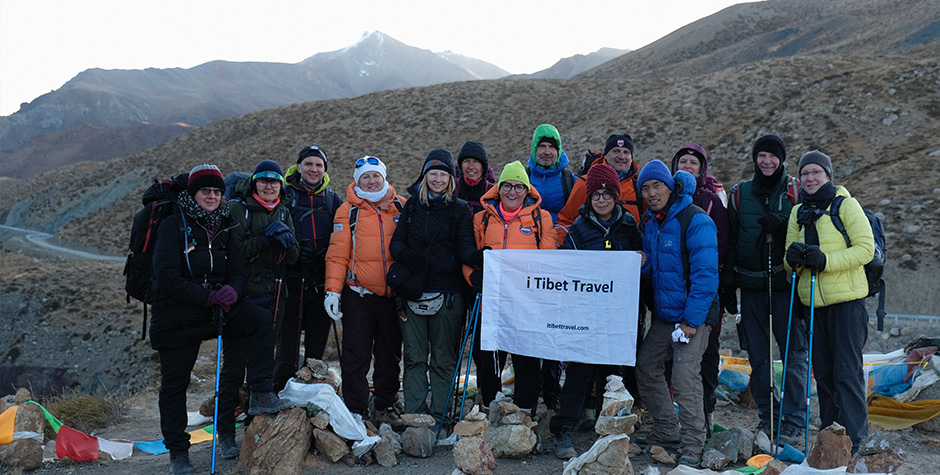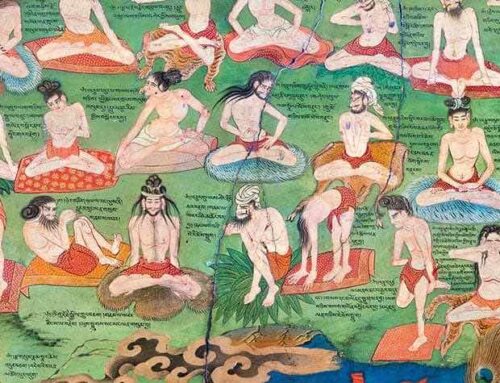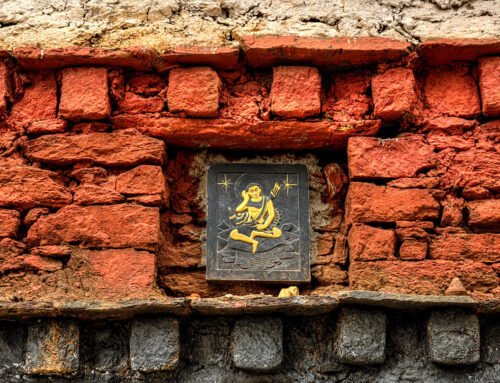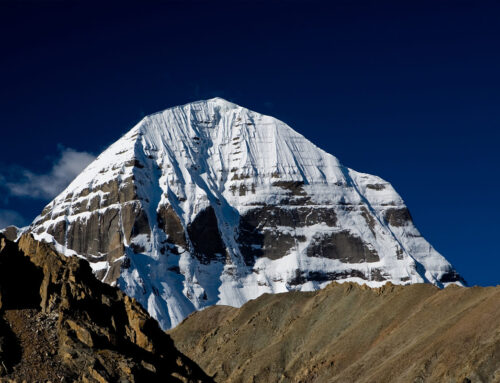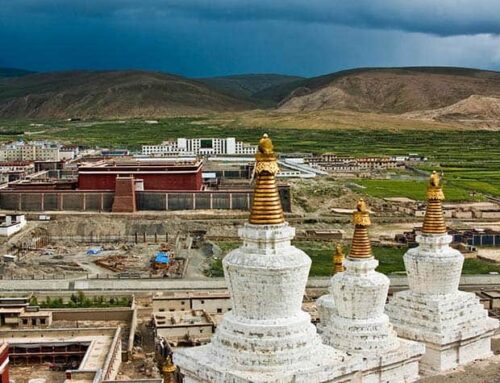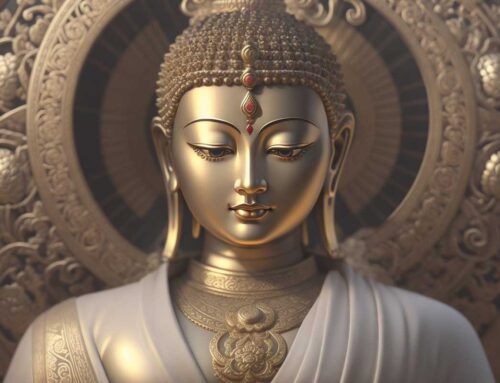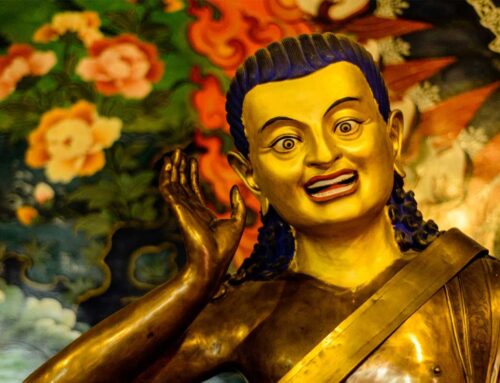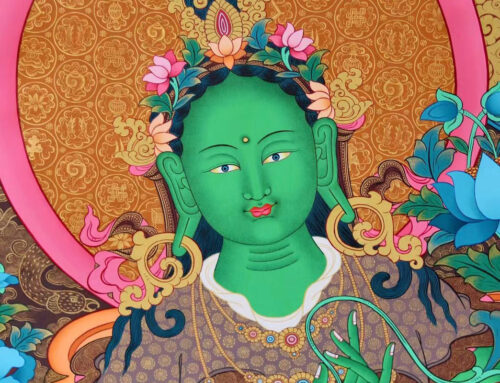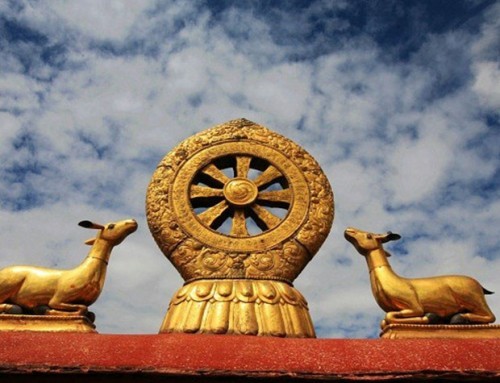Buddhist wheel of life is one of the Most important paintings in Tibetan Buddhism, The initial drawing was designed by Buddha himself. Buddha really encourages this painting to be painted outside every Buddhist temples and monastery. For this reason, the Painting of the Buddhist wheel of life being painted outside all the Buddhist temple and the monastery was to teach the profound Buddhist philosophy of life and perception to more simple-mind farmers or cowherds. So this image is just for communicating the Buddhist philosophy to the general audience.
The Painting of Buddhist wheel of life represent Samsara, The Bhavacakra is popularly referred to as the wheel of life, and may also be glossed as wheel of cyclic existence or wheel of becoming.
Different parts of the Painting on Buddhist Wheel of Life
-
- Images in the center circle represent the three poison; Ignorance, Attachment and Aversion
- The second circle from the center represent Karma.
- The third circle represent the realms of Samsara
- The forth represent twelve links of dependent origination
- The fierce figure holding the wheel is the Mara, the god of death and he represents impermanence in this figure
- The moon represents liberation from the circle existence or Samsara
- The Buddha pointing the moon represent his teaching and also represent he is tell all that liberation is possible
The center layer of the Buddhist Wheel of Life; The three poison
In the center of the wheel are three animals; a pig, a snake, and a bird. these three represent the three poison of in Buddhist philosophy, ignorance, aversion, and attachment, respectively. The pig represents ignorance. This conception is base on the Indian concept of the pig being a dirties animal, it sleeps in the dirtiest place, and eats whatever come to its mouth. A snake represents aversion or anger because the slightest touch to it will trigger a strike. The bird is for the attachment, desire of clinging. The bird which they use in the painting is an Indian bird that is very attached to its partner. These three animal represent three poison which is a core to our Samsaric existence
In most of the drawing, the three animal is shown coming out of the mouth of another, that indicates Aversion leads to ignorance and Ignorance lead to aversion. Under the influence of these three poison beings create, beings create Karma. Shown on the next level.
Second Layer of Buddhist Wheel of Life: Karma
Karma basically means cause and effect. it is said if you plant a seed of chilly, you will only get chilly. So is if you harm others, it will bring back a negative impact on you. In the second level the Karma, the circle is divided into two half, the upper half is usually painted in white or bright color. it also has people moving up to the high realms. the lower half shows people moving down to the miserable stages and the path is colored dark.
This indicates if you do a good deed you will be happy and you will start moving upwards to the Buddha-hood or their next life six realms of Samsara. The next circle is six realms of Samsara.
Third Layer of Buddhist Wheel of Life: The six realms of Samsara.
The third layer of the Buddhist Wheel of Life represent the realms of Samsara. It is divided into six sections for the six realms. realms are divided into three higher realms and three lower realms. Some paint might have five as they would combine the god realm with Demigod realms
The three higher realms are shown in the top half of the circle.
- God realms (Deva): The god in Buddhism is different from the creator god in Hindu and other Non-theistic religion. we believe the creator god doesn’t exist and the god is we believe live within the Samsaric cycle of existence. The god lives a very long life, they enjoy life in abundance and pleasure. These pleasures and abundance of life become a distraction and never think to practice the Dharma. When the death comes nears they will know about the time of death and they would exhaust all their karma ( which brought them to being born in the god realm). and there can clearly see their own next life. being born in god realm in very hard during the time before dying. Another pain in this realm is when you are young and healthy you will have lots of friends and family but during the old age your body would start rotten before your death and No one could come near you for the smell. it is said god dies in lonely and miserable death. So we say God suffers from a long life.
- Demi-god realm (Asura): The Demi- good have all the god abundance and pleasures. they send always keep fighting within themselves and even making war with the god. During their war with god, they would lose every time and they suffer constant fighting and jealousy and being killed or wounded in the wars. So we say the Demi god suffers from the flight and wars
- Human realm (Manuṣya): Humans suffering starts from birth to the end at the death. We suffer from hunger, thirst, cold, separation from friends, being attacked by enemies, not getting as we please. Our suffering is broad categories into the suffering of Birth, old age, sickness, and death. Yet the human realm is most suitable for practice buddha-dharma, as we are not completely distracted by pleasure, or pain and suffering. and we are more capable then beings animal realms.
The three lower realms, as shown in the lower part of the circle:
- Animal realm (Tiryagyoni): Domesticated animals suffer from being exploited by human-like being killed for food and overworked. Wild animals suffer from being attacked and eaten by other animals. They live in constant fear and exploitation.
- Hungry ghost realm (Preta): They are rich and yet they suffer from extreme hunger and thirst. They have a big tummy and a very thin neck not even enough to swallow a single drop of water. they can see the water but can drink. But sometimes they do can manage to eat or drink some but it would only burn their neck and belly as it goes down. We often tell our friends if you are being so miser, you will be born into the realm of hunger god.
- Hell realm (Naraka): In hell beings suffer immeasurable suffering for eons of time. there are eighteen different types of hell, each inflicting a different kind of torment. In hot hell, beings suffer from unbearable heat and continual torments of various kinds. In the cold hell, beings suffer from unbearable cold and other torments.
Among the six realms, the human realm is considered as the best to practice the Dharma. In each realm, you will find a Buddha in all the realms trying to help sentient being to find their way to nirvana.
Outer ring of Buddhist Wheel of Life: twelve links of dependent origination
The twelve links of dependent origination describe the Samsaric rebirth and arising of Dukkha. It shows when certain conditions are present, they give rise to subsequent conditions, which in turn give rise to other condition, these condition arising result in the cyclical nature of rebirths and deaths in Samsara. By contemplating the twelve links, one gains greater insight into the workings of karma; this insight enables us to begin to unravel our habitual way of thinking and reacting
Twelve dependent origination are;
- Ignorance, lack of knowledge – a blind person, often walking, or a person peering out
- Conditioning refers to conditioned phenomena generally but specifically to all mental “dispositions”. These are called ‘volitional formations’ both because they are formed as a result of volition and because they are causes for the arising of future volitional actions – a potter shaping a vessel or vessels
- Consciousness – a man or a monkey grasping a fruit
- Name and Forms (constituent elements of mental and physical existence) – two men afloat in a boat
- six senses (eye, ear, nose, tongue, body, and mind) – a dwelling with six windows
- contact – lovers consorting, kissing, or entwined
- pain – an arrow to the eye
- Thirst – a drinker receiving a drink
- Grasping – a man or a monkey picking fruit
- Coming to be – a couple engaged in intercourse, a standing, leaping, or reflective person
- being born – a woman giving birth
- old age and death – corpse being carried
The figure holding the Buddhist Wheel of Life: impermanence
The fierce figure holding the wheel is the Mara, the god of death and he represents impermanence in this figure.
The moon: liberation
The moon in the painting represents liberation from the circle existence or Samsara
The Buddha pointing to the moon: the path to liberation
The Buddha pointing the moon represent his teaching and also represent he is tell all that liberation is possible. According to a Buddhist text, Buddha once told “I have shown you the path that leads to liberation
But you should know that liberation depends upon yourself.”
We hope this post brings a clearer understanding of one of the most important wall painting in Tibet. you will see this painting where every temples and monastery in Tibet during travel in Tibet.
here are some links of the Buddhist wheel of life in PDF
About Tibet Travel & Tours
Tibet Travel & Tours is a local travel agency in Tibet that offers unique and authentic experiences to travelers from all around the world. As a leading tour operator in Tibet, we provide high-quality Tibet Travel services that are tailored to our clients’ needs and preferences.
Our team of experienced and knowledgeable professionals strives to ensure that our clients have a hassle-free and memorable trip in Tibet. We specialize in various types of tours, including cultural tours, trekking and hiking tours, and adventure tours.
Our commitment to providing exceptional service has earned us a reputation as one of the best local travel agencies in Tibet. Contact us today to plan your unforgettable trip to Tibet.
Explore Tibet with a local Tibetan Travel Agency
If you’re looking to explore Tibet, starting your journey with a reputable Tibetan travel agency in Tibet is crucial. Tibet Travel & Tours is a great choice to begin your adventure with their extensive knowledge of the region and commitment to responsible tourism.
Their Tibet tour packages cater to a range of interests and budgets, making it easy to plan a trip that suits your needs. Before embarking on your tibet tour, it’s essential to have the right Tibet travel information and necessary documents, including a Tibet travel permit.
The Tibet Travel Planner provided by i-Tibet travel is an excellent resource to plan your trip, including tips on what to pack, where to stay, and what to see.
For beginners, the “About Tibet” guide provided by i-Tibet travel offers a comprehensive overview of the region’s history, culture, and top attractions. So, start your Tibet travel plan here with i-Tibet travel and discover the magic of Tibet for yourself.

